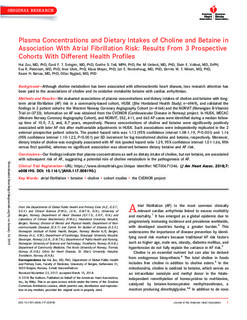| dc.contributor.author | Zuo, Hui | |
| dc.contributor.author | Svingen, Gard Frodahl Tveitevåg | |
| dc.contributor.author | Tell, Grethe S. | |
| dc.contributor.author | Ueland, Per Magne | |
| dc.contributor.author | Vollset, Stein Emil | |
| dc.contributor.author | Pedersen, Eva Ringdal | |
| dc.contributor.author | Ulvik, Arve | |
| dc.contributor.author | Meyer, Klaus | |
| dc.contributor.author | Nordrehaug, Jan Erik | |
| dc.contributor.author | Nilsen, Dennis W.T. | |
| dc.contributor.author | Bønaa, Kaare | |
| dc.contributor.author | Nygård, Ottar | |
| dc.date.accessioned | 2019-03-21T09:34:31Z | |
| dc.date.available | 2019-03-21T09:34:31Z | |
| dc.date.created | 2018-04-13T17:17:35Z | |
| dc.date.issued | 2018 | |
| dc.identifier.citation | Journal of the American Heart Association. 2018, 7 (8), 1-11. | nb_NO |
| dc.identifier.issn | 2047-9980 | |
| dc.identifier.uri | http://hdl.handle.net/11250/2591010 | |
| dc.description.abstract | Background: Although choline metabolism has been associated with atherosclerotic heart disease, less research attention has been paid to the associations of choline and its oxidative metabolite betaine with cardiac arrhythmias.
Methods and Results: We evaluated associations of plasma concentrations and dietary intakes of choline and betaine with long‐term atrial fibrillation (AF) risk in a community‐based cohort, HUSK ([the Hordaland Health Study] n=6949), and validated the findings in 2 patient cohorts: the Western Norway Coronary Angiography Cohort (n=4164) and the NORVIT (Norwegian B‐Vitamin) Trial (n=3733). Information on AF was obtained from the CVDNOR (Cardiovascular Disease in Norway) project. In HUSK, WECAC (Western Norway Coronary Angiography Cohort), and NORVIT, 552, 411, and 663 AF cases were identified during a median follow‐up time of 10.9, 7.3, and, 8.7 years, respectively. Plasma concentrations of choline and betaine were significantly positively associated with later AF risk after multivariable adjustments in HUSK. Such associations were independently replicated in the 2 external prospective patient cohorts. The pooled hazard ratio was 1.13 (95% confidence interval 1.08‐1.19, P<0.001) and 1.16 (95% confidence interval 1.10‐1.22, P<0.001) per SD increment for log‐transformed choline and betaine, respectively. Moreover, dietary intake of choline was marginally associated with AF risk (pooled hazard ratio 1.29, 95% confidence interval 1.01‐1.66, fifth versus first quintile), whereas no significant association was observed between dietary betaine and AF risk.
Conclusions: Our findings indicate that plasma concentrations as well as dietary intake of choline, but not betaine, are associated with subsequent risk of AF, suggesting a potential role of choline metabolism in the pathogenesis of AF. | nb_NO |
| dc.language.iso | eng | nb_NO |
| dc.publisher | Wiley Open Access | nb_NO |
| dc.rights | Navngivelse 4.0 Internasjonal | * |
| dc.rights.uri | http://creativecommons.org/licenses/by/4.0/deed.no | * |
| dc.title | Plasma concentrations and dietary intakes of choline and betaine in association with atrial fibrillation risk: Results from 3 prospective cohorts with different health profiles | nb_NO |
| dc.type | Journal article | nb_NO |
| dc.type | Peer reviewed | nb_NO |
| dc.description.version | publishedVersion | nb_NO |
| dc.source.pagenumber | 1-11 | nb_NO |
| dc.source.volume | 7 | nb_NO |
| dc.source.journal | Journal of the American Heart Association | nb_NO |
| dc.source.issue | 8 | nb_NO |
| dc.identifier.doi | 10.1161/JAHA.117.008190 | |
| dc.identifier.cristin | 1579298 | |
| dc.description.localcode | (C)2018 The Authors. Published on behalf of the American Heart Association, Inc., by Wiley. This is an open access article under the terms of the Creative Commons Attribution License, which permits use, distribution and reproduction in any medium, provided the original work is properly cited. | nb_NO |
| cristin.unitcode | 194,65,20,0 | |
| cristin.unitname | Institutt for samfunnsmedisin og sykepleie | |
| cristin.ispublished | true | |
| cristin.fulltext | original | |
| cristin.qualitycode | 1 | |

